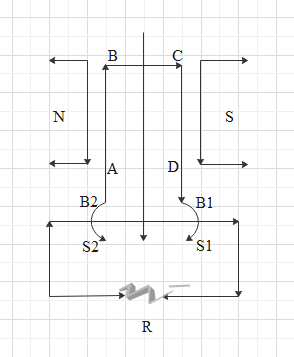
What is d.c. motor? Explain its construction and working with the help of labelled diagrams.
Answer
513k+ views
Hint: Try to understand the concept of Lorentz law which states that the current carrying conductor placed in a magnetic field and electric field experiences a force.
Complete answer:

D.C. motor can be defined as a machine which converts electrical energy to mechanical energy of rotation based on the principle of magnetic effect of current. The DC motor works according to Fleming's right hand rule.
A DC motor consists of the following four parts – field magnet, armature, split ring commutator and the brushesIn common dynamo we use horse shoe magnet but generally we use strong electromagnet as a field magnet.
The armature is an insulated copper wire wound on soft iron which is rotated between the pole pieces using external devices.split ring commutator is a copper ring which is split into two parts and are insulated from each other.
The brushes are used to flow the current induced in the armature to the internal circuit. These are the carbon strips which slide against the split ring.
When the armature is rotated in the clockwise direction, the split rings are connected to the brushes. At this point current is induced in the circuit and the direction of the current in the circuit can be given by Fleming's right hand rule which will be in the direction ABCDS1B1RB2S2A.
Again, after half rotation, the split rings will be connected to the opposite brushes and the current induced will be in the direction DCBAS2B1RB2B1D.
So, we can say that in the external circuit the current flow will always be in the direction from B1 to B2 through R. so, we can say that the current in the internal circuit will always be in the same direction and hence, direct current is obtained.
Note:
For a DC motor, the efficiency can be calculated by dividing the mechanical output power by electrical input power.
For a DC generator, the efficiency is calculated by dividing electrical out power by mechanical input power.
Complete answer:

D.C. motor can be defined as a machine which converts electrical energy to mechanical energy of rotation based on the principle of magnetic effect of current. The DC motor works according to Fleming's right hand rule.
A DC motor consists of the following four parts – field magnet, armature, split ring commutator and the brushesIn common dynamo we use horse shoe magnet but generally we use strong electromagnet as a field magnet.
The armature is an insulated copper wire wound on soft iron which is rotated between the pole pieces using external devices.split ring commutator is a copper ring which is split into two parts and are insulated from each other.
The brushes are used to flow the current induced in the armature to the internal circuit. These are the carbon strips which slide against the split ring.
When the armature is rotated in the clockwise direction, the split rings are connected to the brushes. At this point current is induced in the circuit and the direction of the current in the circuit can be given by Fleming's right hand rule which will be in the direction ABCDS1B1RB2S2A.
Again, after half rotation, the split rings will be connected to the opposite brushes and the current induced will be in the direction DCBAS2B1RB2B1D.
So, we can say that in the external circuit the current flow will always be in the direction from B1 to B2 through R. so, we can say that the current in the internal circuit will always be in the same direction and hence, direct current is obtained.
Note:
For a DC motor, the efficiency can be calculated by dividing the mechanical output power by electrical input power.
For a DC generator, the efficiency is calculated by dividing electrical out power by mechanical input power.
Recently Updated Pages
Two men on either side of the cliff 90m height observe class 10 maths CBSE

What happens to glucose which enters nephron along class 10 biology CBSE

Cutting of the Chinese melon means A The business and class 10 social science CBSE

Write a dialogue with at least ten utterances between class 10 english CBSE

Show an aquatic food chain using the following organisms class 10 biology CBSE

A circle is inscribed in an equilateral triangle and class 10 maths CBSE

Trending doubts
Why is there a time difference of about 5 hours between class 10 social science CBSE

Write a letter to the principal requesting him to grant class 10 english CBSE

What is the median of the first 10 natural numbers class 10 maths CBSE

The Equation xxx + 2 is Satisfied when x is Equal to Class 10 Maths

Which of the following does not have a fundamental class 10 physics CBSE

State and prove converse of BPT Basic Proportionality class 10 maths CBSE




